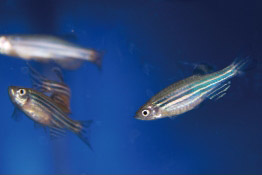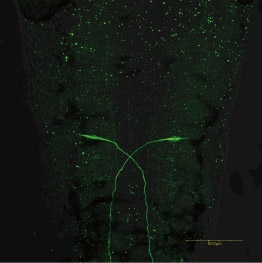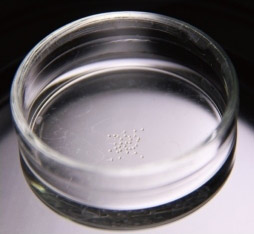HIRATA, Hiromi D. Sc., Associate Professor

- Motor Neural Circuit Laboratory, Hirata Group
- Present Post (since 2010) Assistant Professor, Graduate School of Science, Nagoya University, Japan Postdoctoral Fellow, University of Michigan, USA Postdoctoral Fellow, Institute for Virus Research, Kyoto University, Japan Ph.D., Graduate School of Science, Kyoto University, Japan Awards: Young Investigator Award, Japanese Biochemical Society, 2011 Young Investigator Award, Japan Neuroscience Society, 2010 Career Development Award, Human Frontier Science Program, 2007 Hobbies: Football, Frisbee, Listening to Jazz, Watching Movies
How are synapses formed?
 Zebrafish is a beautiful tropical fish. It is also a model organism that start showing motor behavior as early as 17 hours following fertilization with transparent body facilitating the observation of its interior. In its hindbrain, there is a pair of large neurons called Mauthner cells. By examining the development of zebrafish, Associate Professor Hiromi HIRATA discovered that the formation of synapses (where interneuronal signals pass) on the surface of the Mauthner cells does not solely depend on a genetic program. Synapses are not correctly formed without the signaling process conducted by the nervous system. Dr. Hirata is currently working on a molecular basis of this phenomenon. We talked with him on the subject.
Zebrafish is a beautiful tropical fish. It is also a model organism that start showing motor behavior as early as 17 hours following fertilization with transparent body facilitating the observation of its interior. In its hindbrain, there is a pair of large neurons called Mauthner cells. By examining the development of zebrafish, Associate Professor Hiromi HIRATA discovered that the formation of synapses (where interneuronal signals pass) on the surface of the Mauthner cells does not solely depend on a genetic program. Synapses are not correctly formed without the signaling process conducted by the nervous system. Dr. Hirata is currently working on a molecular basis of this phenomenon. We talked with him on the subject.
- Mauthner cells, essential for fast escape
 Mauthner cells are unique nerve cells. They are found in the hindbrain of fish and amphibians, one pair, in each individual. They appear in an early phase of neurogenesis and are maintained to the adulthood. Since they are large and easily identifiable by certain labeling and are activated at the onset of a rapid escape reflex, they have been studied for a long time with regard to motor circuit. To rapidly escape a danger, such as an external enemy, a zebrafish curves its body as if to form a letter “C” to change its direction. The Mauthner cells are activated to efficiently trigger this curving movement. The Mauthner cell on the left is connected with motor neurons on the right side of the body, and the one on the right, with motor neurons on the left. That is to say, in a zebrafish twisting its body to the right to escape an enemy approaching from the left, the left Mauthner cell is activated, with all the motor neurons on the right side elicited simultaneously to quickly contracting the muscles on the right side only. A C-shape curve of the body, a change of direction, occurs in this manner within one-hundredth of a second.
Mauthner cells are unique nerve cells. They are found in the hindbrain of fish and amphibians, one pair, in each individual. They appear in an early phase of neurogenesis and are maintained to the adulthood. Since they are large and easily identifiable by certain labeling and are activated at the onset of a rapid escape reflex, they have been studied for a long time with regard to motor circuit. To rapidly escape a danger, such as an external enemy, a zebrafish curves its body as if to form a letter “C” to change its direction. The Mauthner cells are activated to efficiently trigger this curving movement. The Mauthner cell on the left is connected with motor neurons on the right side of the body, and the one on the right, with motor neurons on the left. That is to say, in a zebrafish twisting its body to the right to escape an enemy approaching from the left, the left Mauthner cell is activated, with all the motor neurons on the right side elicited simultaneously to quickly contracting the muscles on the right side only. A C-shape curve of the body, a change of direction, occurs in this manner within one-hundredth of a second.- Synapses are not made by genes only
- On the surface of the Mauthner cells, there are numerous synapses, which receive sensory inputs evoked at auditory, tactile and other sensory organs. Dr. Hirata realized that the formation of a group of inhibitory synapses, called glycinergic synapses, requires not only a genetic program but also the transmission of signals itself.
- “I analyzed a variety of zebrafish mutants (individuals with genetic defect) to study their motor behavior formation and development. Some of them lacked glycine receptors, which are essential to transmit signals through synapses. Without the receptors, no signal transmission takes place at glycinergic synapses, and motor behavior abnormalities occur. Meanwhile, I also learned that it is possible to similarly impede signal transmission at synapses in genetically normal zebrafish by applying a receptor-blocking chemical and obtain exactly the same motor abnormalities as those of the mutants. I thought that the receptors, although existing at the right place, did not function normally due to the chemical blockage and that signaling was not conducted as a consequence. But, I later discovered that the application of the chemical made the receptors themselves disappear from the synapses. The normal genetic program should have made the receptors cluster at the synapse, but the chemical hindered this process. This finding led me to conclude that synapse is formed not only by the genetic program but by signal transmission as well. I found similar phenomena with regards to glycinergic synapse in papers. Yet, the molecular mechanism remains a mystery. I decided to design my own original experimental system and elucidate this mystery using zebrafish.”
- Future development in an unexpected direction
 In his future research, Dr. Hirata hopes to identify molecules required for the formation of glycinergic synapses and analyze their functions toward understanding the activity-dependent development of neural circuits.
In his future research, Dr. Hirata hopes to identify molecules required for the formation of glycinergic synapses and analyze their functions toward understanding the activity-dependent development of neural circuits.- “There must be a great number of actors (molecules) in the play, probably including those that play really minor roles. But there must be a handful of star actors, or key molecules, that are particularly important and provide clues to the whole picture. I don’t know who these stars are yet. I don’t know how my research will progress in the future, either. Research becomes far more interesting when it develops in an unexpected direction.”
- Zebrafish mutants for elucidating human diseases
- As another possible research orientation, zebrafish mutants can be used to genetically analyze motor system and its development. Different genetic deficits result in different abnormalities, ranging from stiffening during movement to the absence of fast escape reflex and reduced motor speed. Sometimes genes identified as responsible for abnormalities in zebrafish mutants correspond to genes that cause in humans motor or behavior abnormalities. It is also possible that culprit genes are new and unknown. In the latter case, such new genes shed light on human genetic diseases of which little is known.
- “My research is not directly about human diseases, but studying the fish motor mechanism can lead to a deeper insight of the motor system that is common to vertebrates. Since many human diseases involve motor impairments, I hope that my research will eventually contribute to research into human diseases and treatment for them. In fact, there is an example of a successful experimental ameliorant for motor impairments in zebrafish.”
- Clarifying the obscure – what is fascinating about science
 “Children look like their parents. So the genetic phenomena have been known to humans since the old days, but only vaguely. Nobody was able to explain them as laws and principles. Then in the 19th century, Gregor Johann Mendel appeared and explained them, thereby establishing Mendel’s law. In my research project, I only have a vague idea of the overall picture of what I will achieve. But I believe that one day the language of science will definitely allow me to clarify this something obscure, in a way that is absolutely indisputable. This is what is fascinating about science. Sometimes, research reaches a stalemate, but that’s also when you should fantasize about your research as much as you like. That’s also a very enjoyable moment.”
“Children look like their parents. So the genetic phenomena have been known to humans since the old days, but only vaguely. Nobody was able to explain them as laws and principles. Then in the 19th century, Gregor Johann Mendel appeared and explained them, thereby establishing Mendel’s law. In my research project, I only have a vague idea of the overall picture of what I will achieve. But I believe that one day the language of science will definitely allow me to clarify this something obscure, in a way that is absolutely indisputable. This is what is fascinating about science. Sometimes, research reaches a stalemate, but that’s also when you should fantasize about your research as much as you like. That’s also a very enjoyable moment.”- Enjoying one’s research – that’s the most important
- Dr. Hirata’s fascination with science was established when he entered Graduate School. He still remembers his conversation with his academic advisor when he obtained his doctorate.
- “That was a really absurd question, but I asked him how a research scientist could become successful. Life would be too easy, if you could give an answer to such a question …But my advisor gave me a clear answer. He said: ‘there are two important things. First, one must be in good health.’ At this I was a little taken aback, because I had expected to hear about working hard and collecting useful information. Then he continued: ‘Second, one must enjoy one’s research.’ This, I believe, is a requirement. I then asked him if there were something else, but he said: ‘that’s all.’ He declared that a research scientist will always succeed with these two conditions fulfilled. Now, 10 years later, I understand what he meant. I hope to continue enjoying my research in the years to come.”
- (Interviewed by Yoshiko Tamura 2011)
















